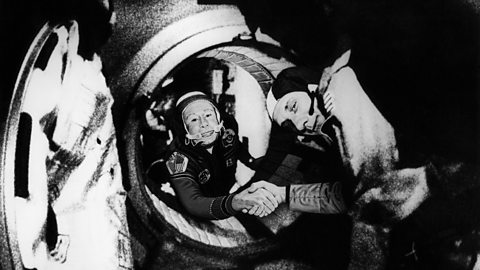Attempts to reduce tension between East and West
¶ŁĆ©³Ł±š²Ō³Ł±š
Following the humiliation of the Vietnam War, the USA made an effort to improve relations with the USSRUnion of Soviet Socialist Republics - collection of states, also known as the Soviet Union. and China, leading to a period in the 1970s known as dƩtente, a word meaning the relaxing of tension.
What evidence is there that tensions between East and West were easing in the 1970s?
- The arms raceA competition between America and the USSR to build more destructive and a higher number of nuclear weapons. was expensive: both sides began to realise that money for nuclear weaponsAn explosive device used as a weapon. The most deadly and destructive weapon developed by humankind. could be better spent on helping their people.
- Following his visit to China in 1972, Nixon showed he was trying to improve relations with the communismA classless society where all property is owned publicly.superpowerCountries who have huge influence or strength, giving them significant global power., and the US dropped its objection to China joining the United NationsThe successor to the League of Nations, the United Nations was established in 1945 as an international organisation designed to keep peace, uphold international law and set standards in human rights.. Nixon hoped that the Chinese might help push North Vietnam to a resolution in the Vietnam War.
- In 1972 SALT IThe first of the Strategic Arms Limitation Talks, an agreement signed in 1972 by US President Richard Nixon and Soviet Union leader Leonid Brezhnev to begin to reduce the number of nuclear weapons owned by America and the Soviet Union. (Strategic Arms Limitation Talks) was signed by US President Nixon and the Soviet leader, Brezhnev. The agreement restricted the number of ICBMs (Intercontinental Ballistic Missiles) both sides could have, but was criticised by some for not limiting the production of new nuclear weapons.
- In 1975 American astronautAmerican way of referring to someone who travels to space. and Soviet cosmonautSoviet way of referring to someone who travels to space. met and symbolically shook hands in space.
- In 1975 the Helsinki Agreement, under which the European borders established after World War Two were recognised and basic human rights such as freedom of speech were agreed, was signed by 35 countries including the USA and USSR. This effectively meant that the Western Allies recognised Soviet control over Eastern Europe. It also meant that, after decades of communist dictatorshipA country ruled by someone who has complete authority., the Soviet Union had signed up to a basic human rightsBasic rights and freedoms that every person should expect to have, eg freedom of speech agreement.

The American astronaut Thomas Stafford (left), and the Russian cosmonaut Aleksey Leonov shaking hands in the connecting passage between APOLLO cabin and SOYOUZ cabin. This space encounter took place during an American-Soviet mission into space
So, why did it all go wrong?
- In 1977, a new US President, Jimmy Carter, entered the White HouseThe official residence of the President of the United States, located in Washington DC. and he criticised the USSR for its abuse of human rights.
- Between 1977 and 1979 the USSR began to replace its out-of-date nuclear missiles in Eastern Europe with SS-20 missiles. This was a new type of battlefield nuclear weapon, leading many in the West to believe that the Soviets had not abandoned the idea of nuclear war or expansionismA policy or ideology that means a country wants to gain more territory. in Europe. The USA responded by developing cruise missileA missile guided towards its target by a computer system. and deploying its own battlefield nuclear weapons to Europe.
- With the arms race apparently on again, and the Soviet invasion of Afghanistan in 1979 the US Congress refused to ratifyAn agreement being officially agreed on by a country.SALT IIThe second of the Strategic Arms Limitation Talks. Although it was signed by US President Jimmy Carter and Soviet Union leader Leonid Brezhnev in 1979, it was not ratified by the US Senate following the Soviet invasion of Afghanistan. (a second agreement of the Strategic Arms Limitation Talks), because as far as they could see the USSR wasnāt committed to limiting the creation of new nuclear weapons.